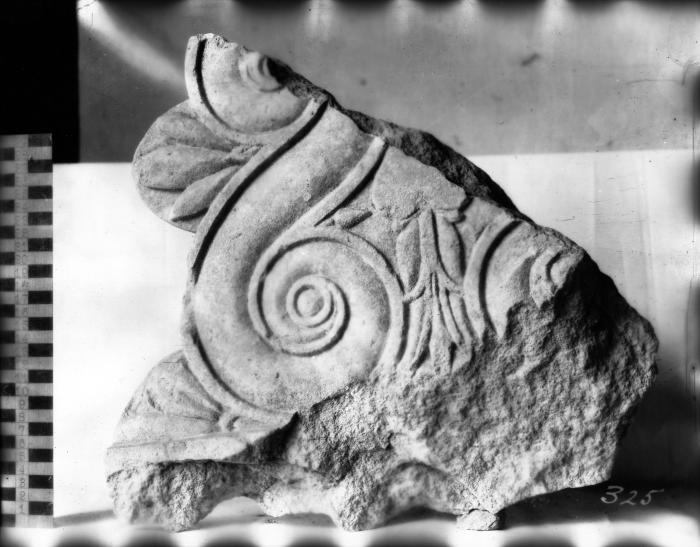-
 Acroterion (?), Arkaik Lahit Kapak Köşesinden Küçük Yaslanmış Aslan
Acroterion (?), Arkaik Lahit Kapak Köşesinden Küçük Yaslanmış AslanR2 Cat. 36
Heykel, Lahit
Mermer, Taş
ca. 500 BC? (Geç Lidya (Pers)?)
In the break of the r. side of the lion there is seen an oblique surface which rises markedly to the proper r. The lion lies on a "base." It has a fat, massive chest and shoulders, short hind legs, with incised claws on the l. hind leg. The l. should...
-
 Aslan pençesi
Aslan pençesiR2 Cat. 37
Heykel
Mermer, Taş
Late 6th or 5th C. BC (Lidya)
The piece has an interesting stylization of the upper parts of the lion’s claws as a flat band and a similarly ornamental flat band at the back of the leg. The paw is well modeled with high rounded forms of toes. No rough drill was used. It is not a ...
-
 Yürüyen Aslan Mermer Heykeli
Yürüyen Aslan Mermer HeykeliR2 Cat. 38
Heykel
Mermer, Taş
ca. 350-330 BC (Geç Lidya (Pers))
The large rounded muscles of the shoulders, body, and hind legs are shown in motion. The mane had a halo-like arrangement radiating around the face, then descending in a triangle over the chest. Upright head and entire chest were turned to his r. A b...
-
 Aslan yürüyen çerçevenin bir parçası
Aslan yürüyen çerçevenin bir parçasıR2 Cat. 39
Heykel
Mermer, Taş
ca. 400 BC (Geç Lidya (Pers))
The fragment has a thin, fine low relief of a lion walking to the r. on a thin, straight ground line. The relief comes from a horizontal band-like part which was the top section of a rather small frame. A bit of projection on the smooth underside ind...
-
 Arkaik Sirenin Alt Kısmı
Arkaik Sirenin Alt KısmıR2 Cat. 40
Heykel
Mermer, Taş
530-500 BC (Geç Lidya (Pers))
Going all around from sex to tail are rows of downward-pointed feathers stylized in leaf-like shapes. Each leaf is oval with median rib. Two vertical rows fill out the triangle between the side feathers and tail on the proper l. They are somewhat bet...
-
 Başsız Yaslanmış Sfenksin Mermer Heykeli
Başsız Yaslanmış Sfenksin Mermer HeykeliR2 Cat. 41
Heykel
Mermer, Taş
Late 6th or 5th C. BC? (Geç Lidya (Pers))
A straight rectangular cut was made to seat the neck, head, and part of the wing (rectangle: W. 0.19, L. 0.15; dowel hole: diam. 0.035, D. 0.035). Judging from the cutting, the head may have been slightly turned to the proper r. The tail is slung up ...
-
 Muhtemelen Tahttan Sfenks
Muhtemelen Tahttan SfenksR2 Cat. 42
Heykel
Mermer, Taş
4th or 3rd C. BC? (Geç Lidya (Pers)?)
Unlike Cat. 41 (Figs. 142-143), this sphinx is made in one piece with the lower back part of the throne. The body is partly in the round (at the front and on top) and partly in relief and, unlike Cat. 41, the relief background extends under the body ...
-
 Kurbağa ve Destek Kabartma Parçası
Kurbağa ve Destek Kabartma ParçasıR2 Cat. 43
Heykel
Mermer, Taş
(Lidya?)
The soft and simple treatment of the frog’s body is very effective. This simplicity (from above the frog looks like an archaic lion) and the very straight line down the spine suggest an archaic monument. The channel might indicate that the piece was ...
-
 Yetiştirme Hayvanı ile Rölyef Parçası
Yetiştirme Hayvanı ile Rölyef ParçasıR2 Cat. 44
Heykel
Mermer, Taş
5th-4th C. BC? (Geç Lidya (Pers)?)
The thick relief block shows an animal charging or rearing to the l. Only the body remains; most of the neck, legs, and tail are broken off. Perhaps the tail curved over the back since there is a trace of the end in the appropriate position. Accordin...
-
 Anthemion Parçası
Anthemion ParçasıR2 Cat. 46
Heykel
Mermer, Taş
530-520 BC (Geç Lidya (Pers))
Fragment of a stele with lotus-volute finial (anthemion).The general type is made clear by the stele Cat. 45 (Figs. 148-149; and a closely comparable fragment from Daskylion (Fig. 152). Preserved is the central part of the finial and the broad raised...
-
 Oda Mezarı Stel
Oda Mezarı StelR2 Cat. 47
Heykel
Kireçtaşı, Taş
520-480 BC (Geç Lidya (Pers))
The plain shaft rises from a simple low rectangular base. The proportion of shaft H. to W. is 4:1. Unlike Cat. 45 and Cat. 46 (Figs. 148-151) the convex volutes rose from two central stems; the eye was an elaborate plastic rosette. A thin, "mannerist...
-
 Marşın Parçası
Marşın ParçasıR2 Cat. 48
Heykel
Mermer, Taş
500-450 BC (Geç Lidya (Pers))
The finial consisted of two spirals symmetrically placed in lyre-like design. H.C. Butler writes, "The two double reversed scrolls carried some crowning feature like a palmette. The scrolls were described by pulvinated bands with raised flat edges. T...